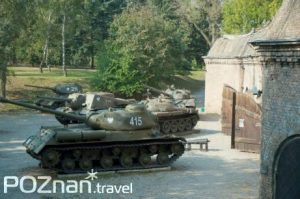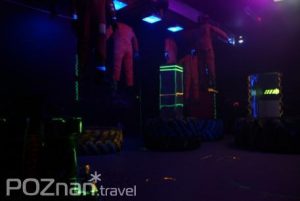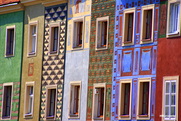Must-Do Things in Poznan
When visiting a new place you are always faced with a dilemma – what is worth seeing, where is it worth going. Poznań is an extraordinary city – open and dynamic, filled with unique places and attractions. Here are a few tips which will allow you to enjoy your stay to the fullest – the 10 Must-Do Things in Poznań.
1. See the billy goats at noon

In the very heart of the Old Market Square you will find the most beautiful Renaissance Town Hall north of the Alps. In 1551, a clock with mechanical billy goats has been installed in the Town Hall. Every day, as the clock strikes noon, on the tower above the clock a door opens, and two billy goats appear. Controlled by the clock’s mechanism, they butt their horned heads 12 times.
Good tip for the late-comers – if you didn’t manage to get to the Rynek before 12pm, there is a vintage billy goat mechanism on display inside the Town Hall.
There is a legend connected to the installing of the billy goats. After the clock was finished, it was supposed to be showcased to all the councilmen and the governor of Poznań. A feast had been prepared for this occasion, but due to the clumsiness of one of the cooks, the haunch of venison which was to be served, was completely burned. To save face, the cook stole two billy goats, which he intended to roast and serve, but they escaped to the Town Hall tower. When the esteemed guests arrived, they saw the two billy goats butting heads on the ledge of the tower. It was then that the governor commanded mechanical billy goats to be attached to clock’s mechanism.
2. Try a St Martin’s Croissant

A St Martin’s Croissant is made with semi-puff pastry and white poppy-seed. Today it has become one of the most famous Polish pastries, protected by the European Union Certificate of Authenticity, which only allows for its production here in Wielkopolska, under strict instructions. The tradition of baking St Martin’s Croissants goes back to the 19th century and is tightly connected with the November 11th church fair at St Martin’s parish. One of Poznań’s pastry makers, in response to the call of the parish priest, asking for donations for the poor, made as many as three trays of croissants and brought them to the church. Other pastry makers soon followed his lead. And so, the tradition of eating St Martin’s Croissants was created, and it has been continued on until the present day.
Only on St Martin’s day (November 11th), Poznań natives and the many tourists eat around 250 tonnes of croissants – that is about 1.25 million individual pastries!
In the Poznań Croissant Museum and Experience you can see the original shows which reveal the secrets of Saint Martin Croissants and other Poznan’s prides. Let’s meet in a beautiful, renaissance tenement house right opposite the Town Hall. The shows are presented live by the locals and prices include croissant tasting!
3. Take a ride on the “Maltanka” train

Along the northern shore of Malta Lake runs the 3.8km route of the kids’ favorite small-gauge train “Maltanka”, which takes her passengers all the way to the New Zoo.The train operates daily from the end of April till the end of September.
On some weekends, the train is drawn by the antique steam engine Borsig (affectionately called “Agusia”) from 1925. For the locomotive to lead the first train at 10.00, it has to be started at 02:30am.
The MPK (Urban Transport Company), whose care “Maltanka” is in, also organizes rides with vintage trams and buses. The buses are equipped with sound systems and they operate on Saturdays, Sundays and holidays starting from the end of April till the end of September. Further information can be found at www.poznan.travel.
Museums of Poznań
Vintage cars… The interiors of a nineteenth century pharmacy… Egyptian mummies… Militaria… Poznań’s museums range from the common to the unique, such as one of only three Museums of Musical Instruments in Europe. Not only tourists enjoy the collections assembled in Poznan’s museums, but also art enthusiasts, book-lovers and enthusiasts in other areas. What’s more, entrance to many is free of charge with the Poznań City Card.
http://www.poznan.travel/en/r/warto-zobaczyc/muzea
Porta Posnania ICHOT

The remarkable Porta Posnania symbolically connects Poznań’s oldest districts of Cathedral Island and Śródka. It attracts its visitors with a multimedia display, educational workshops, cultural events and tours. It presents the fascinating history of Cathedral Island and encourages visitors to tour it with an audio guide. The Porta Posnania is a perfect starting point for exploring the city along the Royal-Imperial Route.
Poznań Croissant Museum and Experience

You can see there the original shows which reveal the secrets of Saint Martin Croissants and other Poznan’s prides. Let’s meet in a beautiful, renaissance tenement house right opposite the Town Hall. The shows are presented live by the locals and prices include croissant tasting! The shows are presented live by the locals and prices include croissant tasting!
National Museum Gallery of Art and Sculpture

The museum owns rich collections of Romanesque and Gothic art, paintings by famous artists – Polish (among others Malczewski, Matejko, Wyspiański) and foreign (an overview of 15th-18th century Italian, 17th century Dutch and 16th and 17th century Flemish paintings). In the Poznań collection there is also the only Claude Monet painting in Poland – The Beach in Pourville.
Archaeological Museum

Poland’s only actual obelisk from ancient Egypt, tools used several thousand years ago by the first inhabitants of present-day Greater Poland, funerary urns in the shapes of faces – these are some unusual sights that can be seen in the Archaeological Museum in Poznan. This is one of the oldest, largest and most active museums in Poland.
Genius Loci Archaeological Reserve

The park presents relics of the early-Piast Middle Ages town fortifications dating back to the 10th Century, and the remains of the Renaissance wall that once surrounded the Cathedral Island. In the state-of-the-art audio-visual hall the visitors can follow through the history of the settlement on the Cathedral Island, which began in the 10th century.
Lech Visitors Centre

Have you ever wondered how log it takes to make LECH beer? What happens during the process of making the golden drink and what it looks like? What is hidden inside the tanks rising above Szwajcarska 11 in Poznań? All you need to satisfy your curiosity is a visit to Lech Visitors Centre.
Poznan Historical Museum

Since 1954, the Museum has been located in the Town Hall, the old seat of the City Authorities. The exhibition shows the history of the city from the thirteenth century to 1954. The most valuable exhibits includes among others the gilded and enamelled crosier from Limoges from the thirteenth century and a large guild of shoemakers rummer from 1651.
Museum of Musical Instruments

One of the few in Europe. Its collection of musical instruments consists of about two thousands items from all parts of the world. The Oscar hall is worth recommending – devoted to Oscar winner Jan A. P. Kaczmarek for the music to the film “Finding Neverland” with the award in the centre.
Models of Former Poznań

The Franciscan Church’s vaults host 3 models: the model of historic Poznań, the model of first Piasts’ town and the model of the Old Market Square. The first one depicts Poznań as presented in Braun-Hogenberg’s picture of 1618 in the scale of 1:150. The second one shows the appearance of Poznań in 10th century. In consideration of blind people, third model (1:100) has been made in the convex technique. The descriptions of the elements are in Braille.
Museum of Arms

The Museum is located on the premises of the former Fort Winiary (the Citadel). Originally used to make gun powder and shells, the facility was later converted to a munitions depot. The biggest attraction of its permanent exhibition are its outdoor displays of military equipment featuring over a dozen military vehicles, nine airplanes, two helicopters, five tanks, as well as numerous canons and mortars.
Entertainment and Recreation
There are lots of recreational activities in Poznan. Which ones are the most interesting? Here are our recommendations.
http://www.poznan.travel/en/r/warto-zobaczyc/rozrywka-i-rekreacja
Aquapark Malta Thermal Baths

Welcome to Malta Thermal Baths – the most modern and at the same time largest indoor water complex in Poland, located by Maltańskie Lake in the very heart of Poznań. On the stretch of about 6 hectares there are 18 pools of the joint water surface area of 500m2. The complex includes an Aqua Park, Sauna World and sports pools with auditorium for 4000 seats.
New Zoo

To see nearly 2 thousand animals of around 140 species, the visitors may use three mapped routes. Animals are kept in conditions possibly closest resembling their natural habitats. In 2009, an elephant house has been opened. The Zoo also offers trains which passengers can use to make their tour of the Zoo. The area of the Zoo also houses a 19th century fort (open for visitors).
Malta Ski Sport & Recreation Centre

Located on the southern shore of the Maltańskie Lake. Its greatest attraction is a year-round artificial slope. Completed in 1993, it is 150 m in length. In 1998 a 560-metre-long summer toboggan-run was opened. In 2012, an all-year-round Adrenaline alpine coaster was launched. A 500 m track allows reaching the speed of 40 km/h.
Pyrland Park Ropes Course

Pyrland Park ropes course, located near Maltańskie Lake, is an excellent place for an active leisure for everyone. There are three rope routes available: high – (for the athletes among us), medium and low (easiest and best suited for beginners). A children’s route is also available (from the age of 3) with an unlimited number of tries.
Go-Karts – karting track

Poznań Indoor Karting is a 2600m2 centre with a professional indoor karting track. The track itself is a few hundred meters long and allows the most exciting experience of riding a real professional race car – a kart.
Laser Paintball – Arena LaserMaxx

LaserMaxx can be played in single or team player mode in a specially designed, 400m2 arena. Inside there are many attractions: a mirror room, a labyrinth, a walking dead room as well as battles between tyres and a wreckage of the iconic Mały Fiat 125p.
Nature
Poznań and the surroundings offer perfect conditions to relax among the forests and lakes. They offer many opportunities for active recreation. Here are some places worth to visit …
http://www.poznan.travel/en/r/warto-zobaczyc/przyroda
Lake Maltańskie

Situated only 2 kilometres from the Old Market Square. Various sporting events are held at the regatta track, most important of which are the world and European championships in water sports. Around the lake you can find sports centres, hiking and bicycle paths, mini golf and boule courses, an all-year-round ski slope with an Adrenaline Alpine Coaster.
Citadel Park

In the 19th century, the Winiary Hill located north of the Old Town was turned into fortifications. After the WW II the place has been turned into a large park (nearly 100 ha in area). Today the Citadel is Poznań’s favourite relax and leisure location. Remnants of the fortress house the Museum of Arms and the ‘Poznań’ Army Museum. It is also the place where, in 2002, Magdalena Abakanowicz, a world-famous Polish artist, created an open-air exhibition of her sculptures.
Morasko Meteorite Natural Reserve

The environs of Poznań abound in areas of high natural value. However, definitely the most interesting and precious object is to be found within the city’s borders! It is a group of meteorite impact craters on the slope of Mount Morasko (Góra Moraska). This hill is the highest rise in the Region of Wielkopolska (154 meters above the sea level).
‘Śnieżycowy Jar’ Reserve

A nature reserve founded for the purpose of protection of the few stands of the spring snowflake (a plant found in the Sudety mountains) in the Wielkopolska region. Tourists visit the reserve massively at the turn of February and March to watch the blooming snowflake, the harbinger of spring, creating beautiful flowery carpets.
Botanical Garden

Poznań Botanical Gardens have been established between 1922 and 1925. In the area of 22 hectares it gathers the impressive collection of over 7 thousand species and varieties of plants from nearly all climate zones on Earth.
For more information please visit:
http://www.poznan.travel/en/r/warto-zobaczyc/zabytki
Enjoy a long photo tour of the most interesting places of Poznan
History of Poznań goes back over 1,000 years. There are many historical monuments which can’t be missed by fans of history!
Cathedral Island

The Cathedral Island was one of the first major centres of the Piast-dynasty state. This is where the first Polish bishopric was established in 968. Inside the cathedral, the tombstones from between the 15th and 16th century, the main Gothic altar from 1512 and 19th century Golden Chapel containing the sarcophagi and statues of first Polish rulers Mieszko I and Bolesław Chrobry are noteworthy.
Town Hall

The town hall in Poznań is undoubtedly the most magnificent Renaissance building in Wielkopolska and one of the finest in Poland. The Grand Vestibule on the first floor (also called the Renaissance Room) ranks among the most beautiful interiors in Poland. The central pinnacle features a clock above which two tin goats appear every day at noon and horn one another.
Parish Church

It is one of the most impressive Baroque sacral edifices in Poland. Impressive facade of the church closes the horizon of the street. In the niches there are statues of saints, and in the middle, on the eagle you can see the figure of St. Ignatius of Loyola, founder of the Jesuit order. Be sure to check out the interior of the temple, which will enchant you with the wealth of forms and lavish décor.
Kaiser’s Castle

This huge neo-Romanesque building, designed by Franz Schwechten, was constructed in the years 1905-10 for German Emperor William II. After WWI when Poland regained its independence, the Castle housed the faculty of mathematics of Poznań University, whose graduates broke the German Enigma code in the 1930’s.
Former Hugger Brewery – now Old Brewery 5050

Buildings of the former Hugger’s Brewery became part of the new complex – multiple award-winning trade, art and business centre. Unusual architecture enters into a dialogue with the site’s industrial past, a multitude of nooks and crannies hide mementos from the beer brewing times: ceramic seals, interior design elements, plaques…
Merchant houses

Located to the south of the town hall, the houses were once used for trade purposes. In the Middle Ages makeshift wooden stalls were erected there where herring, salt, binders, torches, candles and other commodities were sold. The houses featured stalls on the ground floor and apartments on the upper floors.
Former Jesuit College

This four-storey U-shaped building with a spacious courtyard and a two-wing cloister was erected in the first half of the eighteenth century. At present it is the seat of the municipal authorities. In 1806, Napoleon himself stayed there for three weeks. It was then that a German chronicler wrote that Poznań was the capital of the world. This stunning building has also seen concerts by Fryderyk Chopin.
Górka Palace

One of the most wonderful Renaissance baronial mansions in Poland. By Klasztorna Street there is a beautiful Renaissance sandstone portal and an inner courtyard. Now, the palace houses the Archaeological Museum with exhibitions on Greater Poland’s and Western Poland’s prehistory and ancient Egypt.
Fort III

The Fort is a part a complex of 18 forts of so called “Fortress Poznań”. The 19th century Poznań Fortress is one of the best preserved examples of such objects in Europe. The route of the sightseeing leads through both the underground and the aboveground part of the fort.
Okrąglak

A symbol of Poznan’s modernism – ‘Okraglak’, a building designed by a renowned architect Marek Leykam. This is one of the most famous buildings in more than 1000 years of the city’s history. Although it was created in the era pervaded by socialist realism (1949-1954), it represents all of the standard modernist features.

